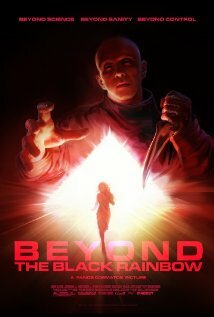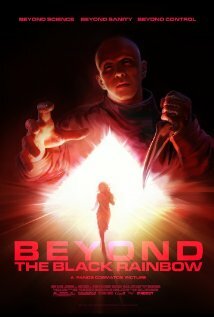In an era where numbing literalism too frequently masquerades itself as art, films that dare to take audiences on unexpected journeys emerge all too infrequently. Beyond the Black Rainbow, which opens at the Grand Illusion tonight, is one of those wonderful rare birds.
The basic plot could pretty much fit on the head of a pin: A silent, psychically-gifted young woman (Eva Allan) quietly endures existence/incarceration in an isolated commune, under the care of Dr. Barry Nyle (Michael Rogers), a therapist who’s far more unstable than the patient he’s overseeing. But Beyond the Black Rainbow turns out to be far more than the sum of its David Cronenberg-gone-Solaris parts. It’s not so much a formula horror/science fiction film as it is a strange, half-remembered, languid nightmare version of one. Fueled by a combination of childhood nostalgia and fevered imagination, first-time director Panos Cosmatos has crafted an immersive, surreal, eerie, and utterly fascinating mind-trip of a movie that transcends its pulp framework.
 Cosmatos grew up around creative parents–his mother was an artist, and his father George P. Cosmatos worked for years as an in-demand action director of films like Tombstone and Rambo: First Blood, Part II–and ironically, Beyond the Black Rainbow was partly born from their parental concern. Restricted from watching many of the films on the shelves of his local video store, Panos found himself conceiving fanciful stories based on the images screaming from the lurid, hyper-colorful display boxes that housed the store’s VHS tapes. Three decades later he’s tapped into those mental movies, and into the dreamlike pacing of that era’s films, to create something truly unique.
Cosmatos grew up around creative parents–his mother was an artist, and his father George P. Cosmatos worked for years as an in-demand action director of films like Tombstone and Rambo: First Blood, Part II–and ironically, Beyond the Black Rainbow was partly born from their parental concern. Restricted from watching many of the films on the shelves of his local video store, Panos found himself conceiving fanciful stories based on the images screaming from the lurid, hyper-colorful display boxes that housed the store’s VHS tapes. Three decades later he’s tapped into those mental movies, and into the dreamlike pacing of that era’s films, to create something truly unique.
Love it or hate it, Beyond the Black Rainbow won’t leave you once you’ve seen it. And not surprisingly, talking to the director is as enlightening and surprising as viewing his odd cinematic progeny.
You’ve described Beyond the Black Rainbow as being inspired by the packaging of old horror and science fiction VHS tapes. I love the notion of you creating a work of art that’s inspired by your outsider’s imaginings of what was in those tapes. Could you elaborate on that?
Well, I sort of had this story idea in my mind about a girl in an institute, that wasn’t really connected to any era. And after my father passed away, I found myself sort of drifting back into that state of nostalgia, and I was going back and watching a lot of the films that made me feel good when I was a kid. I sort of started to realize that I needed to express that, somehow.
As I was thinking and sort of meditating on this nostalgia, I remembered being in that video store–Video Attic–back in the day. I spent hours imagining these movies, and all these kind of disparate elements started to come together.
This other concept that I had was to create a fictional religion in…an art installation. I would see these empty storefronts, with a fold-out table and someone sitting there with some tablets and books for some religion. So I sort of invented this idea of the Arboria Institute. Again, it was just going to be an art installation, but simultaneously I was trying to figure out what facility this girl was in [in the movie]. And then I realized I’d already invented the facility in a divergent creative tangent, without knowing it was this Arboria Institute. And those two things kind of merged.
The movie is set in 1983, and it’s very evocative of the era visually. It has strong visual and thematic influences–I see bits of early Cronenberg and Solaris, and the score and saturated colors bring to mind Dario Argento and the Italian gialli. But the end product doesn’t feel like pastiche.
I became obsessed with color around the time I began [developing] the movie, because I’d always planned to make my first film in black-and-white for budget reasons. It felt at the time like it would be easier to make a movie look beautiful in black-and-white. During that time period, watching a lot of old films, though, I started to fall in love so much with the very rich, saturated color and pulsating grain–just the whole feeling of color. It started to mean so much to me that I realized that I had to make the movie in color.
Your eye for color is definitely at odds with the visual scheme of most modern movies.
Around the time I started coming up with these ideas, movies in the mid-2000’s were still going through this stage of being very visually de-saturated and bland. And I just really wanted to go in the exact opposite direction and make something that was just exploding with color.
You’ve created a movie where not a lot actually happens per se, yet it manages to be very hypnotic.
I always wanted to make the film be in what I would call the Trance genre, like Phase IV and Apocalypse Now…films that are very heavy on mood and ambience and tell the story very visually, not verbally. And I always appreciate films [that are] sort of probing further in those worlds.
The musical score is really immersive and incredibly well-integrated into the film. How early on in the process did the score come in?
Well, when I realized the movie was going to be set in the ’80’s, I determined pretty quickly that I wanted a very rich, thick, juicy-sounding synthesizer analog score. While I was writing, I wasn’t listening to a lot of era-specific music. I actually listened to the score for the Half Life 2 videogame a lot, which I really loved and found really inspiring. But for the actual film itself, I wanted it to be era-specific. Through a stroke of luck, really, a friend of mine introduced me to [composer] Jeremy Schmidt. I showed him a rough cut, and he got involved.
Was there anything that you filmed but didn’t end up using, or wanted to film but weren’t able to, due to budgetary or time limitations?
Well, I’d say 99% of what I wanted is in there. I mean, we storyboarded the movie beforehand, and basically I shot the storyboards. Our schedule was so tight, I didn’t really have time to shoot anything but what was on the page and the storyboards.
In the film, there was going to be animated sequence that was a contrast to the opening narration, that kind of dealt with the darker side of what the Institute had become in the ’80’s. I even roughed it into the cut, with just a voice-over and a temp track. But ultimately we ran out of money, and it sort of fought against the mood. Drawing an element of the film was just too specific. Jeremy wrote an amazing piece of music for it, which hopefully we’ll be able to put out.
The movie’s style is so dreamlike that it will provoke some viewers into wanting rational explanations for some of the situations and the characters’ actions. But I think determining those things for yourself as you’re watching it is part of what makes the movie interesting. Is that a sensibility that you were plugged into when you were making it?
Absolutely. I wrote a story that was pretty straightforward. As simple as it is, though, I decided to allow for atmosphere and to let the characters and the look of the film and everything like that just come…In tune with this idea of creating an imagined film, I didn’t want it to be too story-driven. I wanted it to be more like an open landscape that the audience could project their own fears and desires and memories onto–like a Rorschach test.
What’s next for you, project-wise?
The film that I want to make next is the flip-side to the coin of this film. This film is very controlled–it’s all about control and repression. And I want to explore the flip-side of that, which is just a more primal kind of explosion of emotion…The overall rhythm of it will be more propulsive, I think.
